All throughout this season, we have seen Leeds United favour Patrick Bamford as their first choice striker in their line-ups. Although he has been inconsistent in terms of his goal scoring record and has elicited a fair bit of criticism from the fans, head coach Marcelo Bielsa has been stubborn about starting Bamford eventually losing out on second option, Eddie Nketiah who was on loan for the first half of the season from Arsenal.
During this time, a forward who has been in the shadows is Tyler Roberts. Aside from getting a couple of final minutes as a substitute striker, Roberts first made a serious appearance in November as a number 10 behind Bamford when Pablo Hernandez, the Spanish playmaking lynchpin for Leeds was side-lined due to injury. After another period of absence for a couple of weeks, he made an appearance again last month coming on for Bamford in the 70th minute and netting two goals in a decisive win over Hull City.
In this scout report we shall take a closer look at Roberts’ qualities as a striker. What sets him apart from others in his position, and can he be a reliable option on a consistent basis? A tactical analysis from specific instances of his games will further look into answering these questions.
Background
Roberts was quite the precocious talent at the age of 17. He faced his biggest challenge against Liverpool in the Premier League as a West Brom substitute before a loan spell at Shrewsbury town where his striker instincts would not go unnoticed. Louis Dodds remarked about Tyler Roberts in an interview:
“He was naturally good at reading where the opponents were weak, if the two centre-halves split he knew he could stay in the middle, if a full-back had gone out, he might slip into the space that was left.”
At 180cm and 75kg, the 21-year-old has an average physique for a striker but is powerful and can hold the ball effectively in any duel. Rather than marking up against the last man waiting for the long ball as a target player, Roberts prefers to join the midfield asking for the ball and creating plays.
Tyler Roberts has played 778 minutes for Leeds United as a striker, scoring three goals out of a 2.29 xG, taking 19 shots and hitting the target 57.89% of the time. These statistics suggest the Welsh international clearly deserves more game time than he has been given.
Shooting ability
Let’s begin with an analysis of the most basic feature for any striker: the ability to pull the trigger. Roberts shoots at an average of 2.17 shots every 90 minutes. According to wyscout, 8.8% of his shots are converted into goals. He shots are on target more frequently when he shoots from outside the box (60%) than from inside the box (42.3%), although the goal conversion is higher from inside. This suggests that he can be a threat from long range as well.
If we analyse his shots by pitch distribution and target zones on goal, we see that he most often pulls the trigger from around the penalty area. He is also lethal from just outside the box, both from the left and the right side.
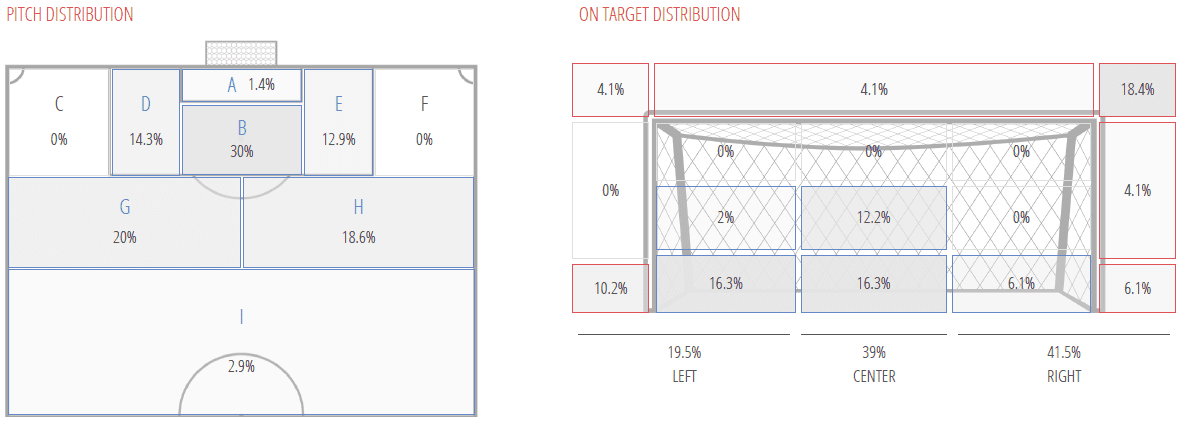
A closer look at Zone B from where he has taken most of his shots (21 out of a total of 70), we see that he has scored goals from both feet, and has hit the target five times with his left foot and six times with his right foot. He is proficient with both feet and mostly targets the bottom left corner or the top right corner.
A precise map of his shots proves that he is not really a ‘tap-in’ artist but rather a clean striker of the ball with both feet from around the penalty area. He mostly waits for the rebound shots or finds space to pull the trigger from crosses that are squared back into him from wide areas.
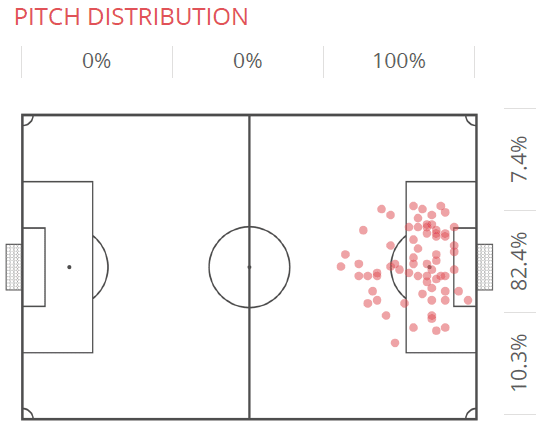
Now that we have looked at the numbers behind his shooting, it is necessary to find out how he makes space for himself to pull the trigger.
Shot creation
Roberts is very clever in recognising the runs made by his teammates. He especially works well with players making runs behind the opposition defensive line pulling it deeper so that he can drift into the hole created to make time and space for himself to pull a shot through.
Below we see the perfect example of how he does this. Here we see him playing against Queens Park Rangers as the second striker behind Bamford. While the ball is in possession with the winger on the left, Bamford makes a run to the far post dragging the line of three defenders along with him. Tyler Roberts makes a run towards the defence and then checks back in the blind side of the midfielder in the box to find space for himself asking for the pass.
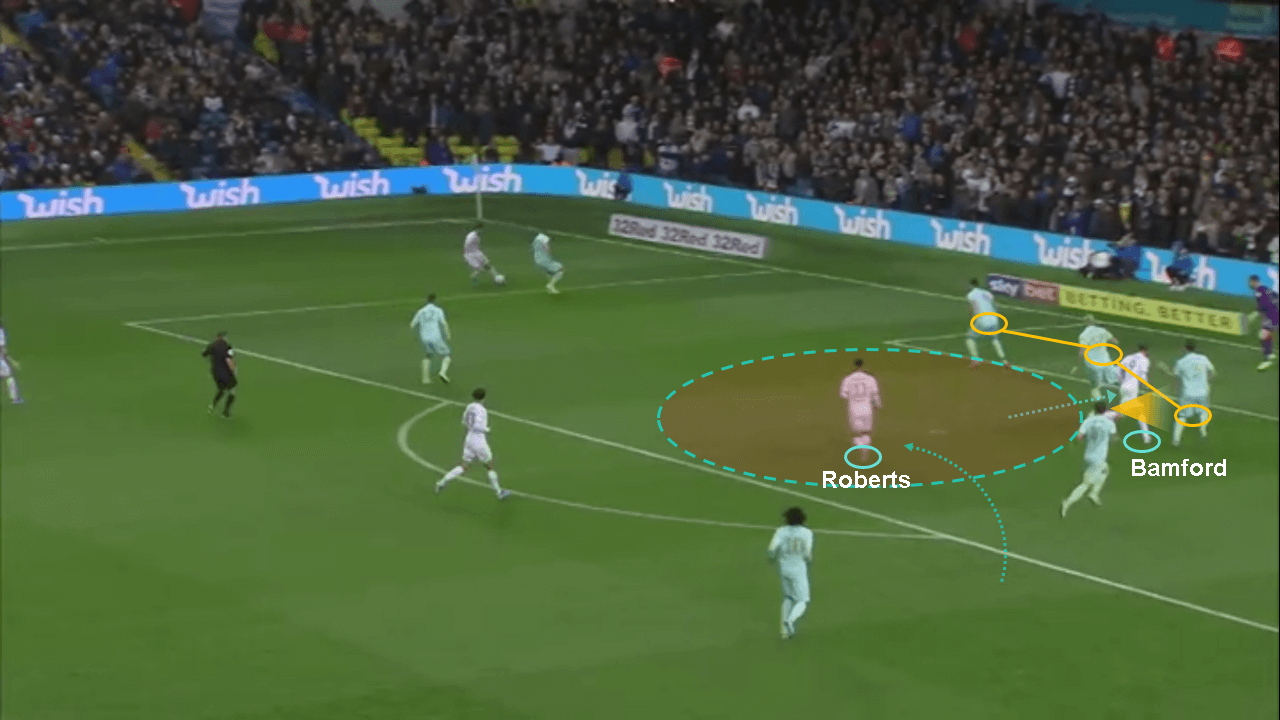
In this situation, he did not get the pass immediately, but found the ball immediately after and scored a goal with his left foot.
Here, in another instance below we see Leeds on the counter attack. Bamford and Roberts are in the centre running at the QPR defence. Bamford continues running on the far side dragging the defensive line back. Roberts initially runs in the direction of the defence but then quickly squares to the left and asks for the ball to his feet just in front of the defence putting him in the perfect position to pull the trigger without being marked.
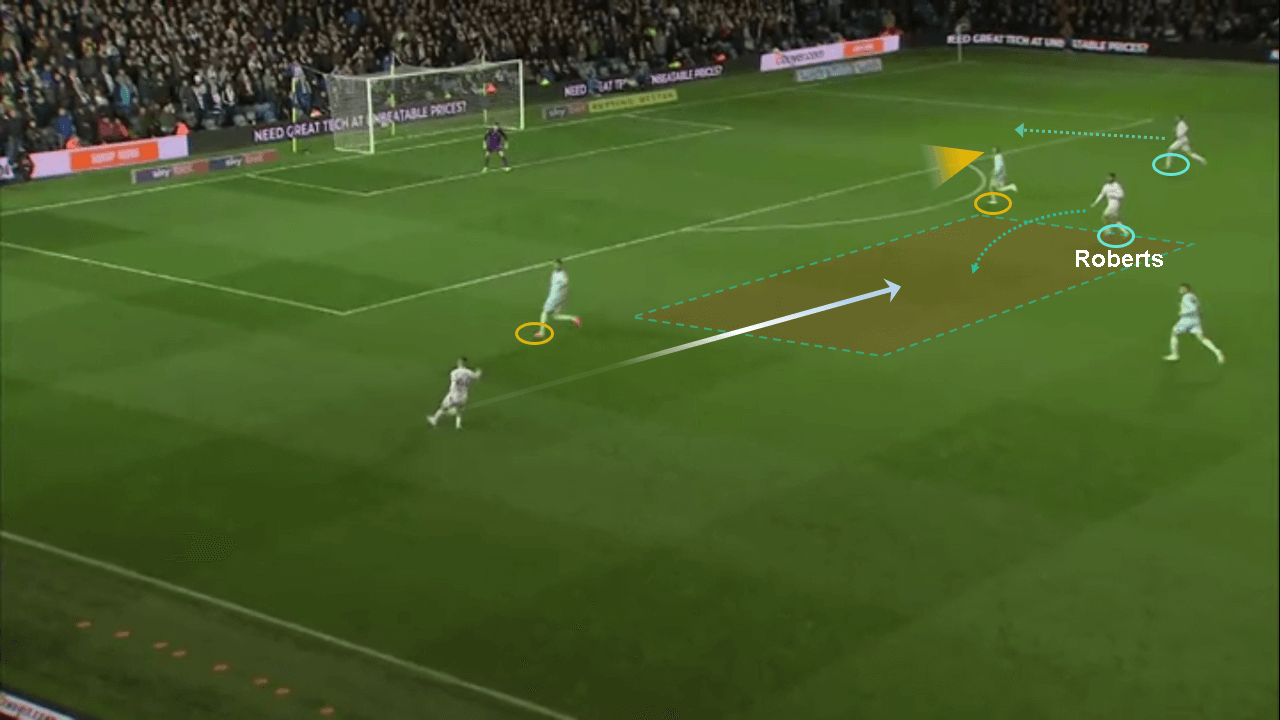
Receiving passes in the corridor of uncertainty
A key characteristic of Roberts is the position in which he likes to receive passes as a forward player. Instead of asking for the penetrating pass behind the defensive line as most strikers do, Roberts tends to drop in the space just in front of the defensive line.
Here we see the perfect example in a wide-angle shot of Leeds in attacking transition. Roberts is playing as the lone striker and is the furthest player up the pitch. But he waits and asks for the pass at a good distance from the last Hull City defender, with lots of space to take a touch, turn and dribble at the defence.
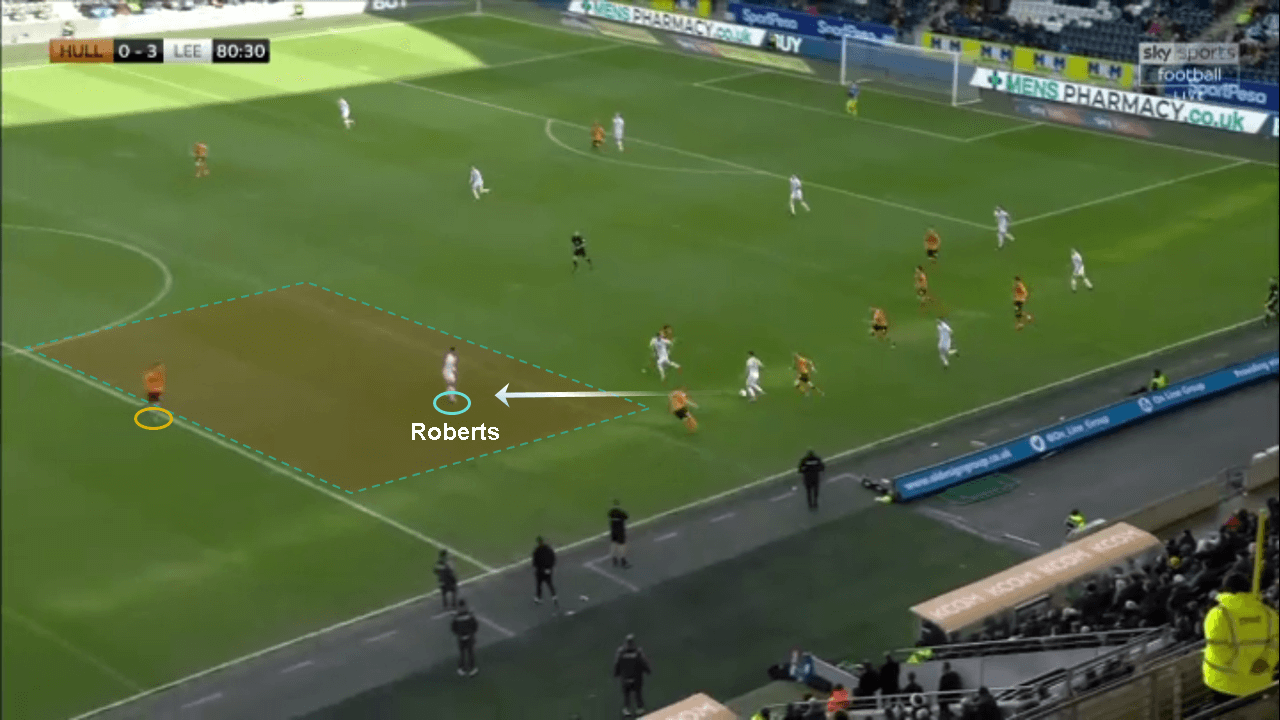
What this does is it puts the defender marking him in a dilemma whether to press him down or to hold his ground and retreat back waiting for a fellow midfielder to intervene. In a team like Leeds where players exercise a remarkable work rate to attack the spaces in possession, Roberts always finds option to play the ball if he is pressured. This move always puts the opposition defence on the back foot. This works best while working as a second striker when a fellow target man is attacking the defensive line, which explains why he was utilised as an attacking midfielder during his time as Hernandez’s proxy.
Let’s take another situation where Leeds is already in the attacking phase well into the opponents half. Here against Blackburn we see that Leeds have players like Mateusz Klich and Bamford in advanced positions pinning the defensive line back. Roberts picks the moment to drop deep in front of the defensive line. Not only does this attract opposition markers towards him, it opens up passing lanes to his teammates.
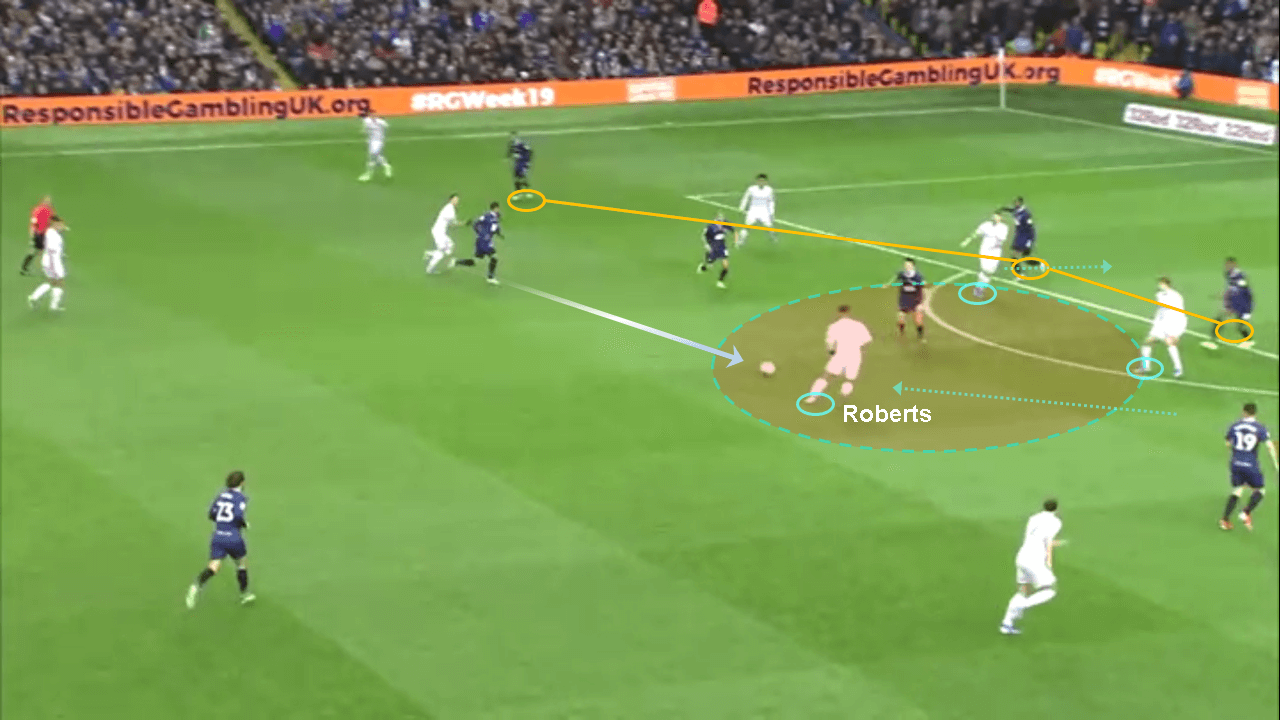
If we look at his overall territorial coverage when he played as a striker, we see that he mostly covers the spaces just in front of the opposition 18-yard box, or in front of the defensive line, in the half spaces. This makes him the perfect player to play as a second striker or an attacking midfielder.
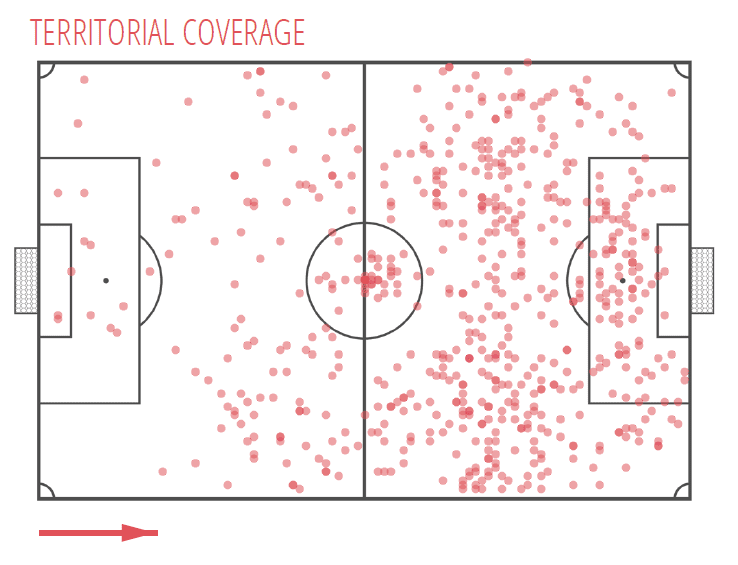
Blindsided runs
What separates Roberts from the rest of the players is his timing. He picks the right moment to ask for the pass, or quickly checks his run while dragging a marker in the opposite direction to make space for himself. He also has a sense for attacking the blind side of defenders and is able to sneak into spaces where the defenders barely anticipate his existence.
Here we see a counter-attack 4v3 scenario where Hélder Costa drives forward in the centre of the pitch with the ball. We see Bamford attacking the defensive line as the primary striker, and Jack Harrison (not in the picture) is offering width on the left as the winger. Roberts makes space for himself on the right in the blind side of the last defender who is focused on the ball-carrying player and asks for the pass.
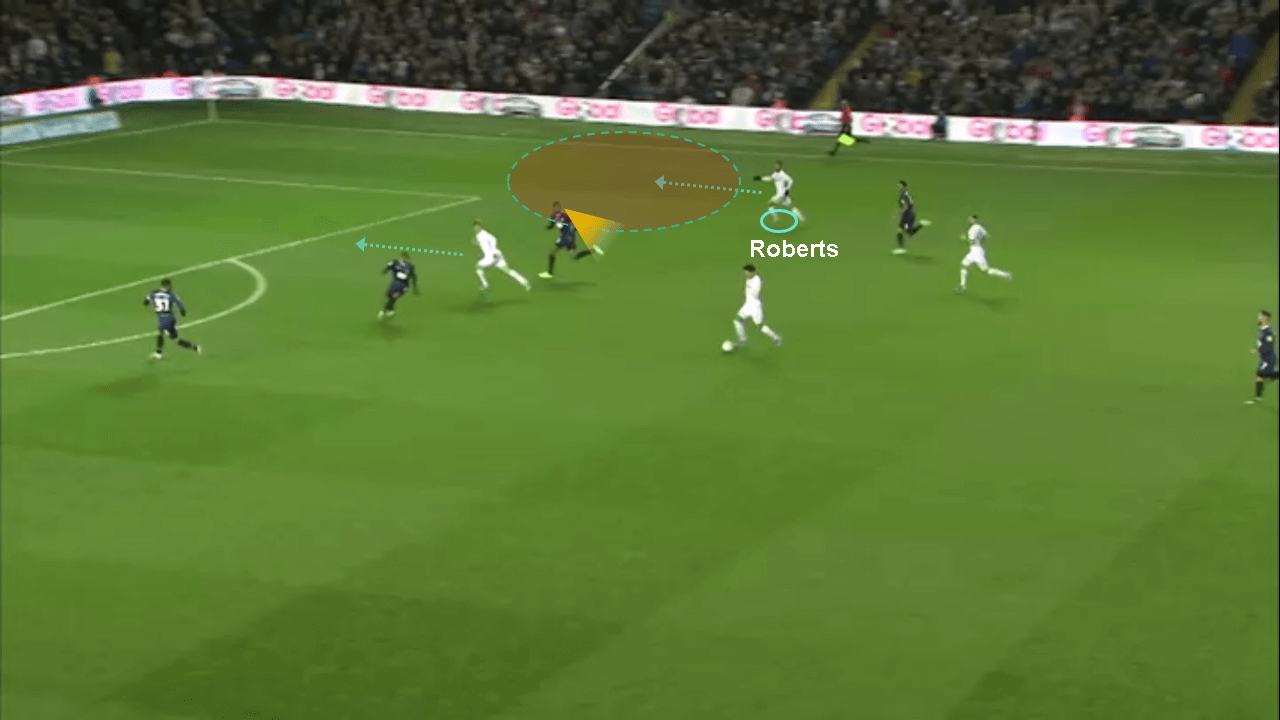
In another instance, we examine his second goal against Hull City. His goal came as a long-range header but in the build up to the goal, we see how he makes a blindsided run behind the defender asking for the long ball. He totally catches the defender off guard to guide it into the far post. Roberts’ headers have been on target 45.45% of the time, scoring 18.18% of his headed shots.

Below we see a Leeds build-up against Hull City, on the right with Luke Ayling carrying the ball. Jamie Shackleton vacates the half-space and Roberts picks the right moment to drop from an advances position attacking that space behind the blind side of the midfielder who isn’t anticipating another player to overload the middle. He receives the ball in the half-space and plays it wide to Costa as a routine Bielsa rotation in the build-up.
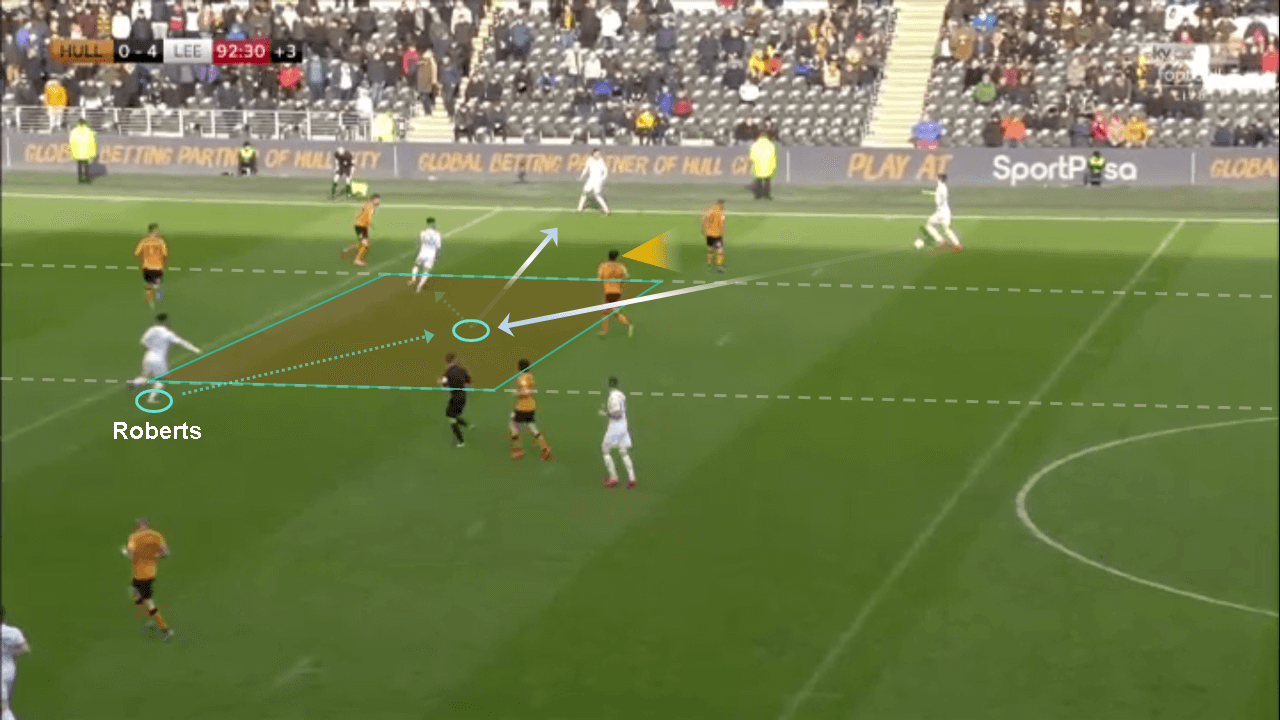
Combining with teammates
Roberts was the logical pick to fill in a spot in the attacking midfield in Hernandez’s absence because of his ability to combine will with fellow players. He isn’t a goal-hungry poacher of a striker and takes a lot of pleasure in creating plays and assisting in the build-up. He averages 3.83 passes per 90 minutes into the final third with a 56.5% accuracy, with 0.83 through passes per 90 with 60% accuracy.
Here we see a situation from a throw-in, where Roberts rotates position with his teammate and while the opponent is drawn to Roberts to whom the ball is thrown, he manages to free his teammate and back heels him a pass to set him up in a good position outside the penalty box.
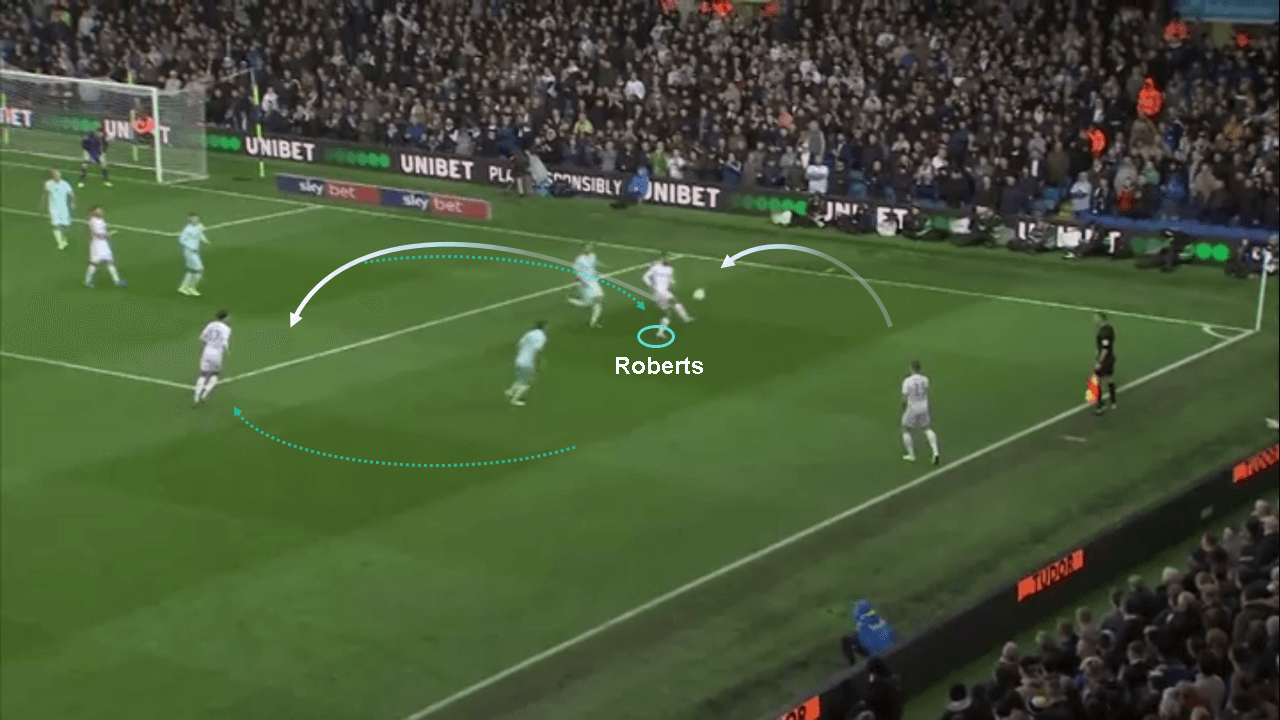
In another scenario, we see a pass from the midfield directed towards Bamford, the target player. Roberts initiates a third-man run in the half-space which is least anticipated and receives the layoff from Bamford setting himself up in a good position to attack the Blackburn defence.
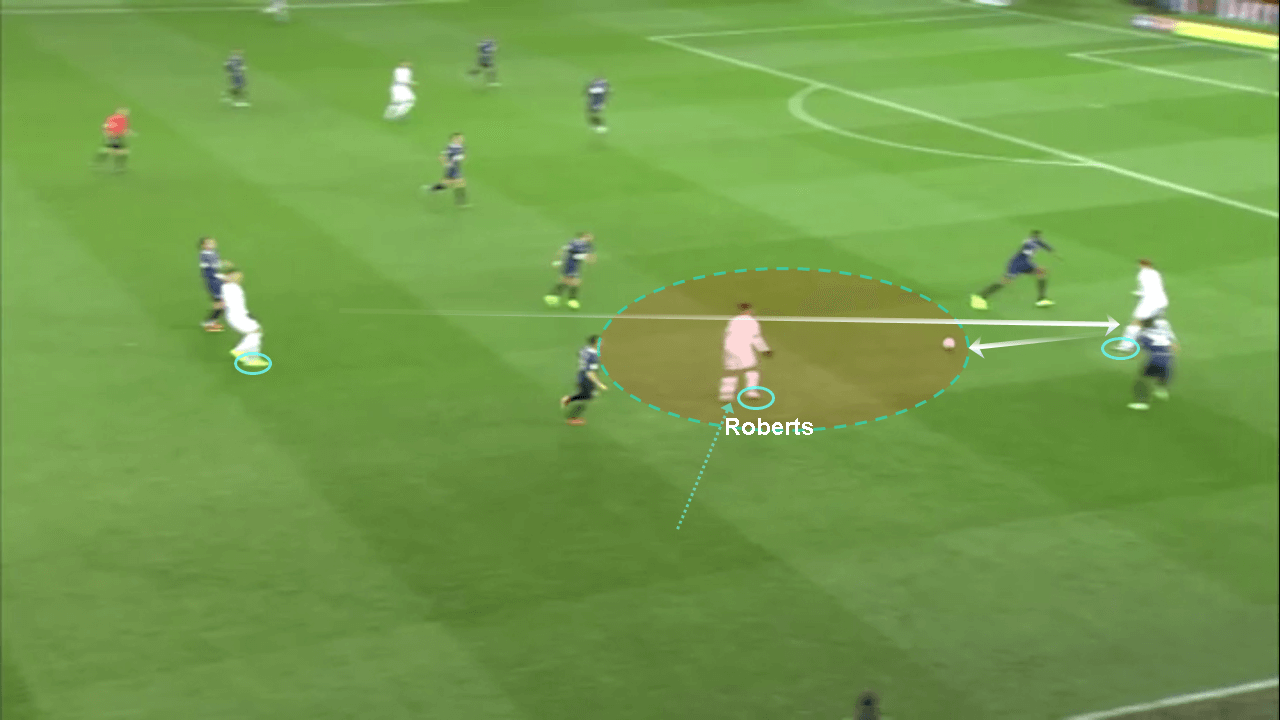
Although he hasn’t had any assists in the minutes that he’s played, he has an xA of 8%
Comparison with Bamford
An obvious question that intrigues most Leeds fans at this moment is whether Roberts is good enough to replace Bamford. In the previous season, in the absence of Bamford, Kemar Roofe was the logical replacement who worked well in pulling the Yorkshire side forward in Bielsa’s early days in charge. In the first half of this season, we saw Eddie Nketiah, the striker on loan from Arsenal, compete with Bamford for the role of the number nine, which made Roberts resort to other roles such as the number 10.
I’ve made a radar comparison of Roberts’ attributes mapped with Bamford’s. We immediately notice that although Bamford has a higher xG figure, Roberts averages more shots on target every 90 minutes. He also loses the ball less often. Roberts has a higher figure in all the duels won comparing to Bamford, but this could be because he has played more minutes in a deeper role as an attacking midfielder than a striker.
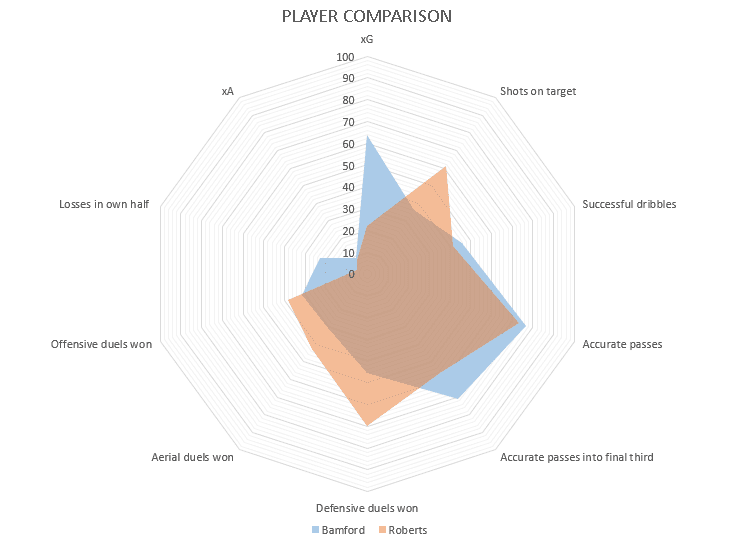
Surely Roberts has proven his utility as a player coming off the bench filling in whatever role the team requires, and his versatility and young age makes him capable of playing a number of positions in the attacking front. But in the long run, where do his opportunities lie?
It is a great deal of pressure for a 21-year-old to fill in as the primary goal-getter for a team like Leeds United, fighting for an automatic promotion into the Premier League with teams like West Brom. Bielsa is also least likely to trust a youngster with that pressure for Roberts’ own good in his career as a striker. However, the lack of minutes begs the question whether he would develop further on loan next season with more minutes at this stage of his playing career. Roberts has himself attested to the massive development he has had under Bielsa, but he does need the crucial minutes for his experience.
Conclusion
Tyler Roberts is an immensely talented and versatile youngster. He is capable of playing in multiple positions and is very clever in reading the game. He is not only an adept goal scorer but also a creative playmaker with a couple of nifty tricks he has gathered from a very young age that sets him apart as a striker.
It is too early to conclude whether he is capable enough to replace Bamford and carry the burden of getting the vital goals for Leeds United in the final part of the 2019/20 EFL Championship season, or whether Bielsa’s tactics has room for the Welshman to be a permanent starter. Nevertheless, if Roberts gets the minutes he deserves for his potential as a player, he has an illustrious career ahead of him.




Comments